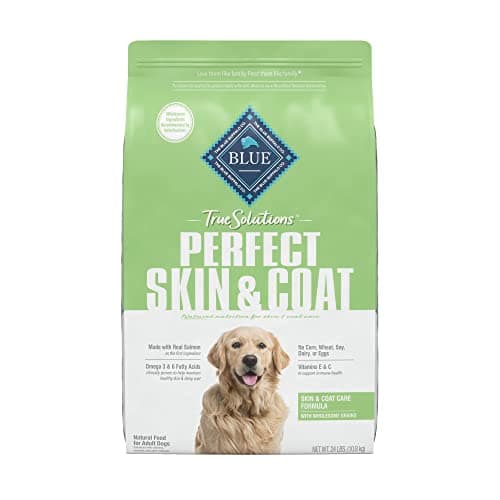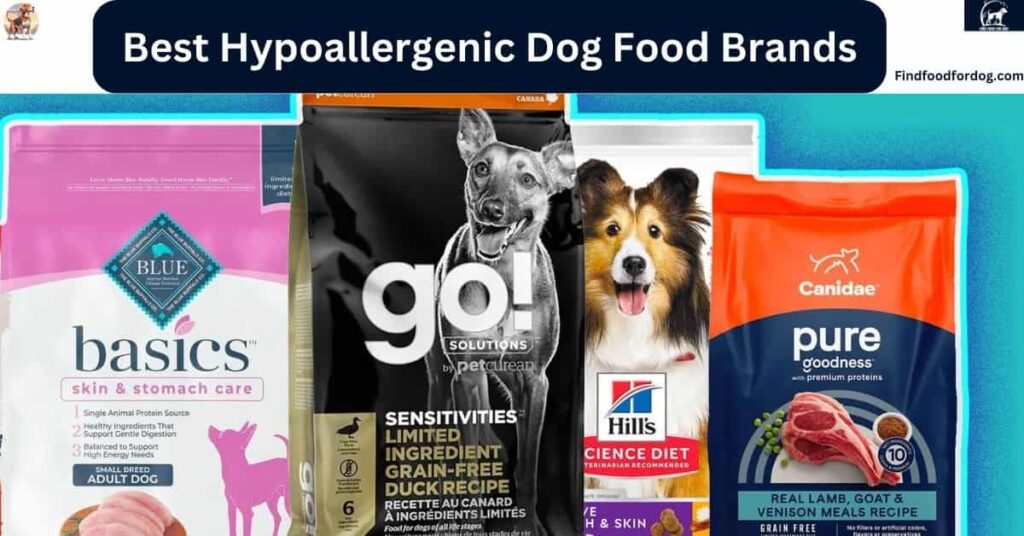The best hypoallergenic dog food for skin allergies typically contains novel proteins and limited ingredients. Options like grain-free formulas or those with single animal proteins can help reduce allergic reactions.
Skin allergies in dogs can stem from various sources, including food ingredients, environmental factors, and genetics. Choosing the right hypoallergenic dog food is crucial for managing these allergies effectively. Many dog owners find that certain ingredients, such as chicken or beef, trigger reactions.
As a result, foods featuring novel proteins like duck or fish are often recommended. Limited ingredient diets can simplify the food choices and help identify allergens. By selecting appropriate hypoallergenic dog food, you can improve your pet's skin health and overall well-being, ensuring they live a happy, comfortable life.
Introduction To Hypoallergenic Dog Food
Hypoallergenic dog food is specially formulated for dogs with skin allergies. It contains fewer allergens. This type of food helps manage skin issues effectively. Pet owners often choose these diets for their furry friends.
Why Choose Hypoallergenic Options
Choosing hypoallergenic dog food can provide several benefits:
- Reduced Allergens: Contains fewer common allergens.
- Improved Skin Health: May alleviate itching and inflammation.
- Better Digestion: Easier for sensitive stomachs to handle.
- Special Ingredients: Often includes unique protein sources.
Many brands use ingredients like:
| Protein Source | Benefits |
|---|---|
| Fish | Rich in omega-3 fatty acids. |
| Rabbit | Less likely to cause allergies. |
| Duck | Unique protein option. |
Identifying Skin Allergies In Dogs
Recognizing skin allergies in dogs is crucial. Common signs include:
- Excessive itching and scratching
- Red or inflamed skin
- Hot spots or sores
- Hair loss
- Dry or flaky skin
If you notice these symptoms, consult a vet. A vet can recommend the best hypoallergenic food. Early detection leads to better management.

Blue Buffalo
Common Allergens In Dog Food
Understanding common allergens in dog food helps you choose the right diet. Many dogs suffer from skin allergies due to certain ingredients. Identifying these allergens is the first step towards relief. Below, we explore the main culprits that trigger reactions in dogs.
Proteins That Often Cause Reactions
Proteins are essential for your dog's health. However, some proteins can cause allergic reactions. The most common protein allergens include:
- Beef
- Chicken
- Lamb
- Dairy
- Fish
Many dog foods contain these proteins. Dogs may react with itching, rashes, or digestive issues. Choose hypoallergenic options with novel proteins like:
- Duck
- Venison
- Rabbit
Grains And Gluten Sensitivity
Grains can also trigger allergies in some dogs. Common grains that cause issues include:
- Wheat
- Barley
- Rye
Gluten sensitivity is a major concern for many dog owners. Symptoms include:
- Itchy skin
- Digestive problems
- Ear infections
Opt for grain-free dog food to avoid these allergens. Look for alternatives like:
- Sweet potatoes
- Peas
- Brown rice
Understanding these allergens helps you make better food choices for your dog. A hypoallergenic diet can significantly improve their quality of life.
The Role Of Diet In Managing Canine Allergies
Diet plays a crucial role in managing canine allergies. Many dogs suffer from skin allergies due to food ingredients. Choosing the right food can alleviate symptoms. A proper diet can improve skin health and boost overall well-being.
Elimination Diet: Finding The Culprit
An elimination diet helps identify food allergies in dogs. This method involves removing certain ingredients from their diet. Follow these steps to conduct an elimination diet:
- Choose a limited ingredient food.
- Feed your dog this food exclusively for 8-12 weeks.
- Monitor for any changes in skin condition.
- Gradually reintroduce one ingredient at a time.
- Observe for allergic reactions or symptoms.
Common allergens include:
- Beef
- Dairy
- Chicken
- Wheat
- Eggs
Identifying the culprit can lead to better dietary choices.
Long-term Dietary Management
After identifying allergens, focus on long-term dietary management. Choose hypoallergenic dog food. Look for formulas with:
| Ingredient | Benefits |
|---|---|
| Novel Proteins | Reduces allergic reactions |
| Limited Ingredients | Simplifies digestion |
| Omega Fatty Acids | Supports skin health |
Regular vet check-ups help monitor your dog's condition. Adjust the diet as needed. A well-managed diet can lead to a happier, healthier dog.

Blue Buffalo
Top Hypoallergenic Dog Food Brands
Choosing the right hypoallergenic dog food can improve your dog's health. Many brands offer special formulas for dogs with skin allergies. Here are some top-rated brands you can trust.
Premium Options For Sensitive Pooches
Premium hypoallergenic dog foods often use high-quality ingredients. These brands focus on nutrition and allergens. Here are a few top picks:
| Brand | Main Protein Source | Key Features |
|---|---|---|
| Royal Canin | Hydrolyzed Protein | Vet-recommended, easy digestion |
| Hill's Science Diet | Turkey | Balanced nutrients, skin support |
| Blue Buffalo | Salmon | Grain-free, natural ingredients |
Royal Canin
Hill's Science Diet
Blue Buffalo
These brands are great for sensitive dogs. They help reduce skin issues and improve overall health.
Budget-friendly Alternatives
You don’t need to spend a fortune on hypoallergenic dog food. Many affordable options offer good nutrition. Here are some budget-friendly brands:
- Purina Pro Plan: Uses salmon and rice. Affordable and nutritious.
- Canidae: Features limited ingredients. Great for sensitive stomachs.
- Merrick: Offers grain-free recipes. Packed with protein.
These options are suitable for dog owners on a budget. They provide essential nutrients without breaking the bank.
Key Ingredients In Hypoallergenic Dog Food
Choosing the right hypoallergenic dog food is crucial for dogs with skin allergies. The right ingredients can help reduce allergic reactions and support overall skin health. Understanding these ingredients is essential for making informed choices.
Novel Proteins And Alternative Carbohydrates
Novel proteins are less likely to cause allergies. They include:
- Duck
- Venison
- Rabbit
- Fish
Alternative carbohydrates are also important. They provide energy without triggering allergies. Common options are:
- Sweet potatoes
- Peas
- Quinoa
- Brown rice
Here’s a quick comparison:
| Protein Source | Allergy Potential |
|---|---|
| Duck | Low |
| Venison | Very Low |
| Rabbit | Low |
| Fish | Medium |
Beneficial Additives For Skin Health
Many hypoallergenic dog foods include beneficial additives. These support skin health and reduce irritation. Key additives are:
- Omega-3 Fatty Acids: Help reduce inflammation.
- Probiotics: Improve digestion and boost immunity.
- Vitamins: Essential for skin repair and health.
- Antioxidants: Protect skin from damage.
These ingredients work together to promote healthy skin. They can make a significant difference for dogs suffering from allergies.
Homemade Vs. Commercial Hypoallergenic Diets
Choosing between homemade and commercial hypoallergenic dog food can be challenging. Each option has its benefits and drawbacks. Understanding these differences helps dog owners make informed decisions for their pets.
Pros And Cons Of Homemade Meals
Homemade meals offer flexibility and control. However, they require careful planning.
| Pros | Cons |
|---|---|
|
|
Homemade Dog Food
Ensuring Balanced Nutrition At Home
Creating a balanced homemade diet is vital for your dog’s health. A mix of proteins, carbs, and fats is essential.
- Proteins: Chicken, turkey, and fish are great choices.
- Carbohydrates: Brown rice and sweet potatoes provide energy.
- Fats: Fish oil supports healthy skin.
- Vitamins: Include leafy greens for added nutrition.
Consider consulting a vet. They can help you design a balanced meal plan.
Transitioning To A Hypoallergenic Diet
Transitioning your dog to a hypoallergenic diet can improve skin health. It helps reduce allergic reactions and promotes overall wellness. Follow these simple steps to ensure a smooth transition.
Gradual Diet Changes
Start by mixing the new hypoallergenic food with the current food. This prevents digestive upset and helps your dog adjust. Follow this plan:
- Days 1-3: 25% new food, 75% old food
- Days 4-6: 50% new food, 50% old food
- Days 7-9: 75% new food, 25% old food
- Day 10: 100% new food
Monitor your dog's appetite during this period. Some dogs may need more time to adjust.
Monitoring Your Dog's Response
Keep a close eye on your dog's reaction to the new diet. Look for these signs:
- Improved skin condition
- Less itching or scratching
- Better coat shine
- Healthy digestion
Note any changes in behavior or health. Consult your vet if issues arise. Regular check-ups can ensure your dog's well-being.
:strip_icc()/oneplus_sensitive-c831eb0f80914383989f1ccf8b2bd528.jpeg)
Purina Pro Plan
When To Consult A Veterinarian
Understanding when to consult a veterinarian is crucial for your dog’s health. Skin allergies can be complex. If your dog shows persistent symptoms, a vet can provide tailored advice.
Persistent Symptoms Despite Diet Change
Sometimes, a change in diet isn’t enough. If your dog continues to scratch, bite, or show irritation, seek veterinary help. Look for these signs:
- Red or inflamed skin
- Excessive scratching or biting
- Hot spots or sores
- Ear infections
- Gastrointestinal issues
Take advice from Pet Expert Dr Marty
Consult a veterinarian if these symptoms persist for over two weeks. They may suggest additional tests or treatments. Early intervention helps prevent further discomfort.
Additional Treatments For Allergies
A veterinarian may recommend various treatments alongside diet changes. These treatments can improve your dog’s quality of life.
| Treatment Type | Description |
|---|---|
| Medication | Antihistamines or steroids can reduce inflammation. |
| Topical Treatments | Shampoos or sprays soothe irritated skin. |
| Allergy Testing | Identify specific allergens for targeted treatment. |
| Immunotherapy | Gradually desensitize your dog to allergens. |
Regular vet visits are essential for monitoring your dog’s condition. Adjusting treatment plans ensures effective management of allergies.
Frequently Asked Questions About Best Hypoallergenic Dog Food for Skin Allergies
What Is Hypoallergenic Dog Food?
Hypoallergenic dog food is formulated to minimize allergic reactions in dogs. It typically contains limited ingredients and specific protein sources. This food helps reduce skin irritations and digestive issues caused by common allergens. Always consult your veterinarian before making dietary changes for your pet.
How Can I Tell If My Dog Has Allergies?
Signs of allergies in dogs include itching, redness, and skin infections. You may also notice excessive licking or chewing of paws. Allergies can lead to gastrointestinal issues, like vomiting or diarrhea. A vet can help diagnose allergies through tests and recommend suitable hypoallergenic food options.
What Ingredients Should Hypoallergenic Dog Food Contain?
Hypoallergenic dog food should contain novel protein sources, such as duck or venison. Additionally, it often includes easily digestible carbohydrates like sweet potatoes or peas. Avoid common allergens like wheat, soy, and dairy. Always check the ingredient list to ensure it meets your dog's specific needs.
How Long Does It Take For Hypoallergenic Food To Work?
It typically takes around 8 to 12 weeks to see improvements. During this time, observe your dog's skin and digestive health. Consistency is key; ensure your dog eats only the hypoallergenic food. Consult your veterinarian if you don’t notice any changes in your dog's condition.
Shop Form Devoted Pet Foods UK
Conclusion
Finding the right hypoallergenic dog food can significantly improve your dog's skin health. Prioritize options with high-quality ingredients and minimal allergens. A well-chosen diet not only alleviates skin issues but also enhances overall wellness. Always consult your vet before making changes to ensure your furry friend gets the best care possible.














